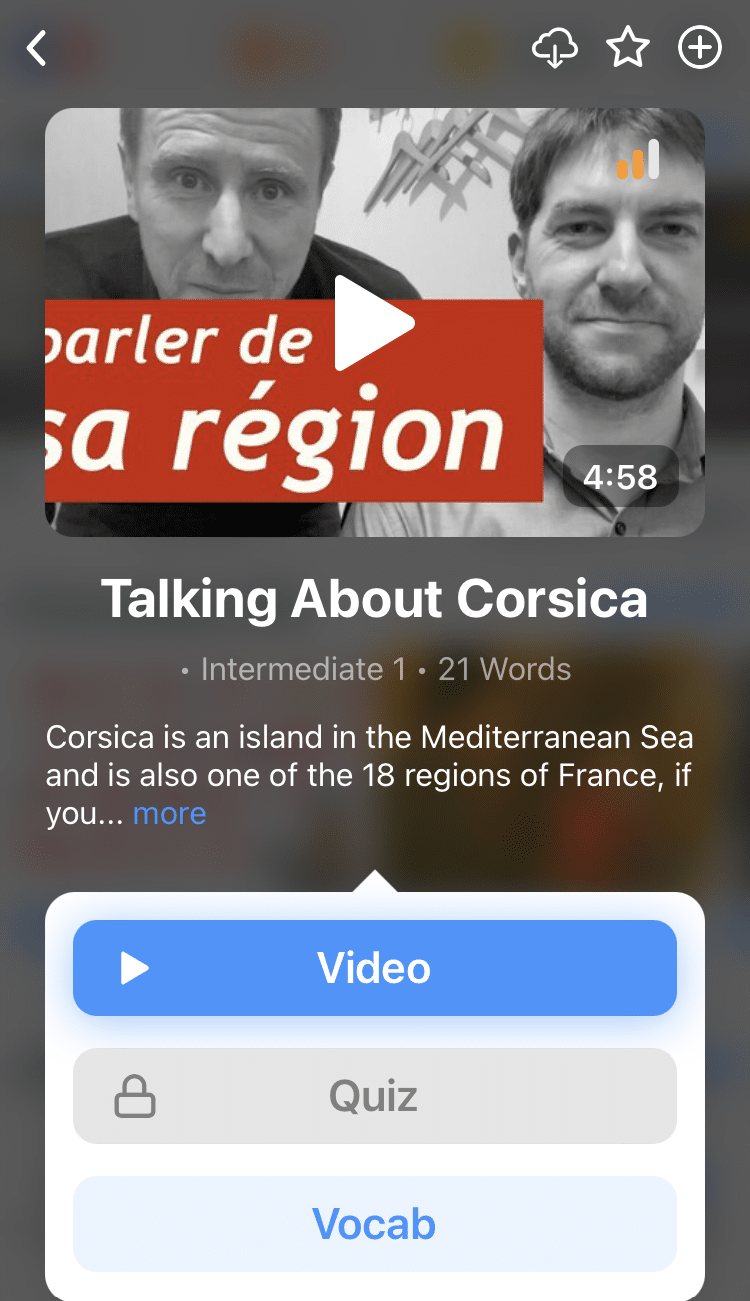
The Four Aspects of French
The aspects of French (which describe how an action relates to the passing of time) are surprisingly intuitive. Actually, if you know even a little French, you’ve already used aspect without realizing it.
Read on to add a new grammar concept to your French repertoire. Trust me, it’s an easy win.
Contents
Download: This blog post is available as a convenient and portable PDF that you can take anywhere. Click here to get a copy. (Download)
What is Aspect in French?
When we talk about French verbs, we primarily talk about verb tense.
Verb tense lets us place an action somewhere in time.
For example, the sentence hier, j’ai parlé à ma mère (yesterday I talked to my mother), the passé composé (perfect) tense of the verb parler (to speak) lets us know that this action happened sometime in the past.
Verbal aspect is closely related to verb tense. But unlike tense, verbal aspect describes how an action relates to the passing of time. That means that verbal aspect isn’t actually anchored somewhere in our perception of time. Instead, it gives us information about how the action happens during that moment or that period of time.
As such, verbal aspect occurs in past, present and future actions. Because it isn’t talking about a specific point in time, it can describe how the action takes place at any time.
In many cases, no special conjugation pattern is required to reflect aspect in French, but there’s one exception. Aspect actually changes the verb conjugation in the French past tense.
If you’re familiar with the French past tense, you’ve probably worked extensively with this aspect before—you just didn’t realize it!
The Four French Verb Aspects
Now that we know what aspect in French is, it’s time to look at the aspects themselves. There are four verbal aspects in French, so let’s dive in!
1. L’aspect habituel (Habitual Aspect)
Our first aspect in French is called l’aspect habituel. As expected, this aspect indicates a verb or action happens repeatedly and is somewhat of a habit.
In fact, this aspect can show that these actions are regularly occurring in all tenses: the past, present or future.
French doesn’t have a specific tense that reflects the aspect habituel. Instead, context lets us know if an action is a habit or regularly occurring, which is the same way we express this aspect in English.
To illustrate this, let’s look at the following sentence in French:
Mon mari boit du café le matin.
My husband drinks coffee in the morning.
Here, the verb boire (to drink) is conjugated into the present tense (boit), but that doesn’t give us much information about how often this action occurs. Instead, we look at other clues in the sentence. The adverb le matin lets us know that this happens in the morning, implying that this is a regular occurrence every morning.
Looking at how French is used in context is very helpful for learning it. You can do this by consuming French content like books and podcasts, or using a program like FluentU.
FluentU takes authentic videos—like music videos, movie trailers, news and inspiring talks—and turns them into personalized language learning lessons.
You can try FluentU for free for 2 weeks. Check out the website or download the iOS app or Android app.
P.S. Click here to take advantage of our current sale! (Expires at the end of this month.)
2. L’aspect imparfait (Imperfect Aspect)
The next aspect in French is called the aspect imparfait, which demonstrates an action expressed by a verb is incomplete, was never completed or will never be completed. In that sense, the action is “imperfect.” If it was “perfect,” the action would be complete.
The aspect imparfait also indicates a past action that occurred over a period of time, not just at a specific point (English: “used to”). Even though the action may have been completed or finished at a later point in time, that end is unknown at that moment.
Like the aspect habituel, this aspect can also be expressed in the past, present or future. L’aspect imparfait is a little special, though.
In the past tense, this aspect actually has its own set of conjugations, and you’ve probably already learned them! Verbs reflect the imperfect aspect through the imparfait (imperfect) past tense.
Check out this example:
Je travaillais pendant la tempête.
I was working during the storm.
Here, the verb travailler (to work) is in the imperfect past verb tense. This shows that the speaker was working during a period of time, but the sentence doesn’t indicate when the speaker finished working. Because the ending is unknown, the sentence takes on the aspect imparfait.
3. L’aspect perfectif (Perfective Aspect)
The aspect perfectif is the opposite of the aspect imperfectif. As such, the perfective aspect shows that an action is complete, has been completed or will be completed.
This can be expressed in the past, present or future, but note that it’s conjugated in the past tense—more specifically, passé composé (perfect tense).
Again, you’ve probably already encountered these verb conjugations for the aspect perfectif.
Let’s take a look at an example:
Ils ont marché à la bibliothèque à 13h.
They walked to the library at 1:00 p.m.
In this sentence, the passé composé of the verb marcher (to walk) lets us know that this action was completed, and we can assume that they arrived at the library. Because this action is finished, it’s in the aspect perfectif.
4. L’aspect progressif (Progressive Aspect)
Our last aspect in French is the aspect progressif, which shows an action expressed by a verb is ongoing. Unlike the aspect habituel, it doesn’t indicate a regularly occurring action. Rather, it shows an action is “in the middle” of happening.
In English, we show this through the progressive verb tense. For example, “I am working” or “she was dancing” shows that the action is currently happening.
In French, there’s no specific progressive verb tense, so we show this aspect through adverbs such as en ce moment (in that moment), en train de (in the process of) and pendant (while).
Like all our other aspects, the aspect progressif can happen in the past, present or future.
Let’s look at a sentence with the aspect progressif:
Nous sommes en train de discuter le projet.
We are in the middle of discussing the project.
In our example, the adverb en train de lets us know that the action of discussing the project is in the middle of happening. Since it’s unknown whether the verb will be completed or not, the verb uses the aspect progressif.
FluentU takes authentic videos—like music videos, movie trailers, news and inspiring talks—and turns them into personalized language learning lessons.
You can try FluentU for free for 2 weeks. Check out the website or download the iOS app or Android app.
P.S. Click here to take advantage of our current sale! (Expires at the end of this month.)
Quiz on French Aspect
Learning the four aspects of French was pretty easy, wasn’t it? Now it’s time to apply your knowledge.
Take a look at the following eight sentences. For each, determine whether it’s showing the aspect habituel, the aspect imperfectif, the aspect perfectif or the aspect progressif. Check out the answer key to see if your answers are correct.
- En ce moment, elle travaille.
- Le garçon a acheté le livre à 10h.
- Je mangeais de la viande.
- Nous allons à l’école tous les jours.
- J’ai bu du café chez moi.
- Ma mère danse le mercredi.
- Les enfants jouaient quand l’homme est arrivé.
- Je suis en train de jouer.
Answer Key
- English: At the moment, she is working.
Answer: Aspect progressif.The adverb en ce moment (at the moment) lets us know that she’s in the middle of working at the time of speaking.
- English: The boy bought the book at 10:00 a.m.
Answer: Aspect perfectif.The passé composé of the verb acheter (to buy) shows us the action has been completed within the context of the sentence.
- English: I was eating meat.
Answer: Aspect imperfectif.The use of the imparfait verb tense of manger (to eat) shows us that the action hasn’t been completed.
- English: We go to school every day.
Answer: Aspect habituel.The words tous les jours (every day) tells us that this is a recurring action (a habit).
- English: I drank coffee at my place.
Answer: Aspect perfectif.The use of the passé composé of the verb boire (to drink) shows us that the action of drinking coffee is finished.
- English: My mom dances on Wednesdays.
Answer: Aspect habituel.The words le mercredi (every Wednesday) lets us know that the mother goes dancing as a habit on Wednesdays.
- English: The children were playing when the man arrived.
Answer: Aspect imperfectif and aspect perfectif.
This one was a trick! There are two aspects here: the first is the aspect imperfectif with jouaient (were playing), and the second is the aspect perfectif with est arrivé (arrived). This sentence shows that the children were playing (an incomplete, imperfect action) when the man arrived (a complete, perfective action). - English: I am in the middle of playing.
Answer: Aspect progressif.The words en train de (in the middle of) let us know that the action is in the middle of happening.
Another French verb complexity, done and dusted. Nice one! But you kind of already knew these aspects in French, didn’t you?
And one more thing...
If you like learning French on your own time and from the comfort of your smart device, then I'd be remiss to not tell you about FluentU.
FluentU has a wide variety of great content, like interviews, documentary excerpts and web series, as you can see here:

FluentU brings native French videos with reach. With interactive captions, you can tap on any word to see an image, definition and useful examples.

For example, if you tap on the word "crois," you'll see this:

Practice and reinforce all the vocabulary you've learned in a given video with learn mode. Swipe left or right to see more examples for the word you’re learning, and play the mini-games found in our dynamic flashcards, like "fill in the blank."

All throughout, FluentU tracks the vocabulary that you’re learning and uses this information to give you a totally personalized experience. It gives you extra practice with difficult words—and reminds you when it’s time to review what you’ve learned.
Start using the FluentU website on your computer or tablet or, better yet, download the FluentU app from the iTunes or Google Play store. Click here to take advantage of our current sale! (Expires at the end of this month.)



